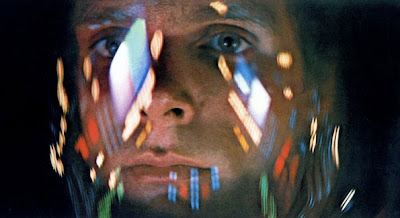Looking Back and Askance at Kubrick's 2001
 I finally made it past the apes and got Stanley Kubrick’s most perplexing monkey off my back by sitting through an entire screening of his keystone sci-fi epic, 2001: A Space Odyssey, with only occasional nod-offs to hinder my progress. I figured the “Dawn of Man” opening of this odd Odyssey was meant to signify Man’s Inhumanity to Man or something, with that imposing black rectangle and eerie voices representing the Almighty, or maybe the Spirit of Mankind. Then again, perhaps this whole prologue could be a pretentious load of crap. I worship frequently at the altar of Kubrick and I know 2001 generally ranks high (and for many, at the top of) the Kubrick cannon, but I’ll take some of his supposedly “lesser” films (The Killing and Lolita come to mind) over some of his artsy, and sometimes long-winded and fartsy, years-in-the-making masterpieces.
I finally made it past the apes and got Stanley Kubrick’s most perplexing monkey off my back by sitting through an entire screening of his keystone sci-fi epic, 2001: A Space Odyssey, with only occasional nod-offs to hinder my progress. I figured the “Dawn of Man” opening of this odd Odyssey was meant to signify Man’s Inhumanity to Man or something, with that imposing black rectangle and eerie voices representing the Almighty, or maybe the Spirit of Mankind. Then again, perhaps this whole prologue could be a pretentious load of crap. I worship frequently at the altar of Kubrick and I know 2001 generally ranks high (and for many, at the top of) the Kubrick cannon, but I’ll take some of his supposedly “lesser” films (The Killing and Lolita come to mind) over some of his artsy, and sometimes long-winded and fartsy, years-in-the-making masterpieces.
I wavered in and out of consciousness, hoping Shelley Winters or Timothy Carey would wander in from a prior Kubrick undertaking and liven up the movie‘s slow, meandering tone, as I simultaneously mulled over the fact all the awesome classical music and vivid outer space and outta-site imagery accompanying it don’t completely hide the fact there's nothing of much consequence happening in this Dead Zone for long stretches of the movie‘s 148-minute running time. I know the special effects are impressive and light years ahead of other 1960’s films; however, more than once visions of my old Lite-Brite set were recalled, as familiar psychedelic neon colors filled the screen. The Jackie-O Pillbox hats on those deliberately lumbering spaceship flight attendants (or whatever they are) also scream “1962: A Space Odyssey,” but there’s enough fantastic sights and events on display to understand why audiences have been duly impressed by this mega-hit for decades, even if I still find myself referencing another 1960’s touchstone film as I ponder, “What’s it all about, Stanley?”
To be fair, some of the future is foreseen- that landing pad looks Disco 70’s enough to envision a white-tuxed John Travolta strutting around it as he points up to the landing ships, and one of the spaceships resembled a super-sized R2D2 after a few too many Big Macs (from the Spaceship designs alone, it‘s clear George Lucas must have caught this movie a few times before creating Star Wars, with a little Star Trek glory thrown in for good measure).
 The stoically sexy Keir Dullea and not-bad-either Gary Lockwood show up after an hour, bringing Hal and the most intriguing storyline with them, and I finally became the involved viewer Kubrick intended me to be up until the point I actually was into the movie. As astronaut Dave Bowman, Dullea anchors his scenes, and his intelligent playing easily takes the acting honors, even though one suspects Captain Kirk could kick that sneaky computer's ass deep into the Final Frontier a lot sooner than the calm, reasonable Dave.
The stoically sexy Keir Dullea and not-bad-either Gary Lockwood show up after an hour, bringing Hal and the most intriguing storyline with them, and I finally became the involved viewer Kubrick intended me to be up until the point I actually was into the movie. As astronaut Dave Bowman, Dullea anchors his scenes, and his intelligent playing easily takes the acting honors, even though one suspects Captain Kirk could kick that sneaky computer's ass deep into the Final Frontier a lot sooner than the calm, reasonable Dave.
 With the main, and maybe only, storyline coming to a resolution, you get the idea Kubrick might wrap things up neatly, but he’s still got plenty of artistry to go, leading to a head-trippy and kind-of endless closing act. Upon leaving the theater, I heard a group discussing the meaning of the film’s final images. One young man stated “He (Keir Dullea’s character) was reborn and went back to change the course of humanity.” Sounds good to me, as his explanation was a lot better than anything I could come up with- it could just be jealousy towards his insightfulness on my inane part, but I pondered if this sage guy’s grandfather wrote for Kubrick and passed the film's "true meaning" onto subsequent generations.
With the main, and maybe only, storyline coming to a resolution, you get the idea Kubrick might wrap things up neatly, but he’s still got plenty of artistry to go, leading to a head-trippy and kind-of endless closing act. Upon leaving the theater, I heard a group discussing the meaning of the film’s final images. One young man stated “He (Keir Dullea’s character) was reborn and went back to change the course of humanity.” Sounds good to me, as his explanation was a lot better than anything I could come up with- it could just be jealousy towards his insightfulness on my inane part, but I pondered if this sage guy’s grandfather wrote for Kubrick and passed the film's "true meaning" onto subsequent generations.

0 Comments:
Post a Comment
<< Home